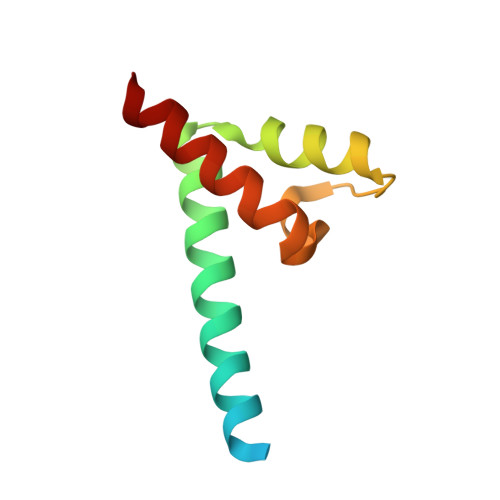Assembly and stoichiometry of the core structure of the bacterial flagellar type III export gate complex
Fukumura, T., Makino, F., Dietsche, T., Kinoshita, M., Kato, T., Wagner, S., Namba, K., Imada, K., Minamino, T.(2017) PLoS Biol 15: e2002281-e2002281
- PubMed: 28771466
- DOI: https://doi.org/10.1371/journal.pbio.2002281
- Primary Citation of Related Structures:
5H72 - PubMed Abstract:
The bacterial flagellar type III export apparatus, which is required for flagellar assembly beyond the cell membranes, consists of a transmembrane export gate complex and a cytoplasmic ATPase complex. FlhA, FlhB, FliP, FliQ, and FliR form the gate complex inside the basal body MS ring, although FliO is required for efficient export gate formation in Salmonella enterica. However, it remains unknown how they form the gate complex. Here we report that FliP forms a homohexameric ring with a diameter of 10 nm. Alanine substitutions of conserved Phe-137, Phe-150, and Glu-178 residues in the periplasmic domain of FliP (FliPP) inhibited FliP6 ring formation, suppressing flagellar protein export. FliO formed a 5-nm ring structure with 3 clamp-like structures that bind to the FliP6 ring. The crystal structure of FliPP derived from Thermotoga maritia, and structure-based photo-crosslinking experiments revealed that Phe-150 and Ser-156 of FliPP are involved in the FliP-FliP interactions and that Phe-150, Arg-152, Ser-156, and Pro-158 are responsible for the FliP-FliO interactions. Overexpression of FliP restored motility of a ∆fliO mutant to the wild-type level, suggesting that the FliP6 ring is a functional unit in the export gate complex and that FliO is not part of the final gate structure. Copurification assays revealed that FlhA, FlhB, FliQ, and FliR are associated with the FliO/FliP complex. We propose that the assembly of the export gate complex begins with FliP6 ring formation with the help of the FliO scaffold, followed by FliQ, FliR, and FlhB and finally FlhA during MS ring formation.
Organizational Affiliation:
Graduate School of Frontier Biosciences, Osaka University, Suita, Osaka, Japan.














